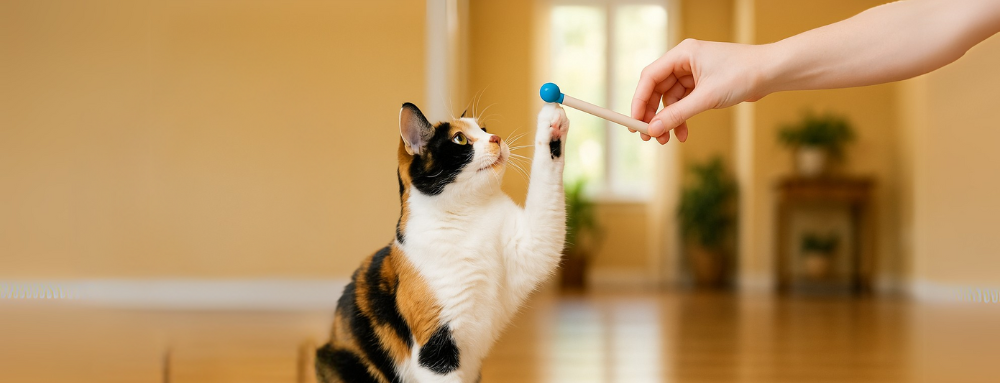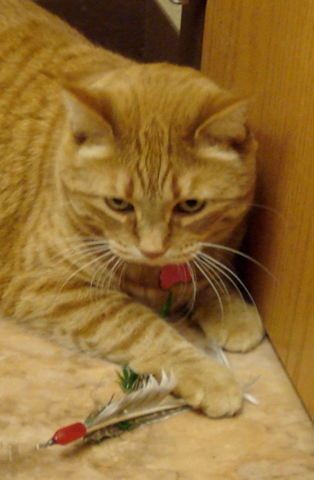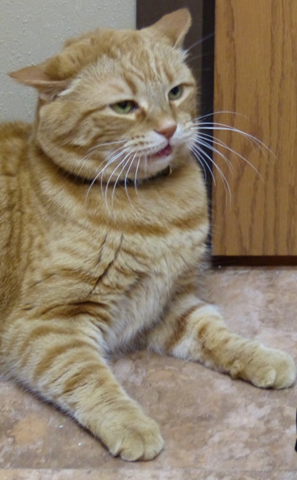
Veterinarians are uniquely positioned to aid caregivers in understanding normal feline behavior, preventing undesirable behaviors, and providing information on positive reinforcement training. Successful positive reinforcement training can strengthen the caregiver-cat bond and improve the quality of life for the individual cat.
Understanding Normal Feline Behavior
- As both a predator and a prey species, cats are naturally solitary hunters, and their hunting instincts persist in the home environment.
- Without appropriate outlets for those instincts, normal feline behaviors may manifest in a way that is undesirable to the caregivers in the home.
- Normal feline behaviors may vary based on life stage (see 2021 AAHA/AAFP Feline Life Stage Guidelines).
Object Play Behavior
- Normal play behavior in cats and kittens mimics the hunt. Chasing, pouncing, biting, and clawing their “prey” is normal.
- Most kittens have a very strong play drive, while normal play behavior in senior cats may be more subdued.
- Object play behavior can also be highly individual, with some cats playing more than others.
Urination & Defecation
- When not constrained by a home environment, cats will often dig and posture around a large area before settling on a spot to urinate or defecate.
- Soft substrates (e.g., sand, dirt), which can be used to bury the urine or fecal matter, are typically preferred.
- Urine and feces also contain pheromones, which send communicative signals to other cats in the environment.
- Messages communicated include the time of the cat’s presence, sexual or mating status, and emotional state
- Therefore, it is normal for urine (and rarely fecal) marking to occur in a large variety of areas
- The deposition of scent, so that the environment contains the cat’s smell, can provide a calming effect for cats
- Urine or fecal soiling or marking outside of the litter box is undesirable for caregivers but not inappropriate for the cat. Causes include an underlying medical problem, feline idiopathic cystitis, or other sources of distress in the physical and/or social environment of the cat (see 2014 AAFP/ISFM Guidelines for Diagnosing and Solving House-soiling Behavior in Cats, 2013 AAFP/ISFM Environmental Needs Guidelines, and 2024 AAFP Intercat Tension Guidelines: Recognition, Prevention, and Management).
Scratching
- Scratching is a normal feline behavior that functions to maintain claw health, deposit the cat’s scent in the environment, and leave a visual cue to other cats of the cat’s presence.
- Cats may have preferences for different types of scratching surfaces; carpet, wood, rope, and cardboard are commonly preferred substrates.
- Also, cats may prefer scratching surfaces that are vertical, horizontal, or angled.
- These preferences may change with life stage, particularly if chronic conditions such as degenerative joint disease develop as the cat matures.
- An example is a senior cat who previously scratched on vertical surfaces and now only scratches on horizontal surfaces
- See the Claw Friendly Educational Toolkit for more details.
Jumping and Climbing on (or under) Furniture
- In an outdoor environment, it is normal behavior for cats to climb trees in order to survey the area or to hide from what they fear.
- Vertical space and hiding options, such as cat beds and boxes, are critically important in an indoor environment to provide elevated options and to increase overall space. These preferences may also vary depending on life stage.
Attention-seeking Behaviors
- Certain vocal cues, such as the cat’s meow, are often targeted toward the caregiver in order to solicit attention.
- Cats may also return to locations in which attention has previously been given (such as jumping into the caregiver’s lap, onto a desk, or into the bed).
- Cats engage in other human-directed social behaviors, such as rubbing (when the cat rubs part of their body against a person).
- Rubbing is often directed toward the caregiver when the cat is seeking attention or when the cat has been reunited with their caregiver after a brief separation, and it helps strengthen the human-cat relationship
- Engaging in rubbing on furniture and/or other surfaces marks territory and can help calm the cat in stressful situations
- Some normal attention-seeking behaviors may be undesirable to the caregiver (e.g., vocalizing), and those undesirable behaviors may have been unintentionally positively reinforced by the caregiver by previously giving the cat attention while the cat was engaging in such behavior.
Eagerness to Learn
- Cats of all ages have the ability to learn from their surroundings. Energy level, curiosity, attention span, and motivation to learn are traits which are highly variable in cats, with some individuals having significantly more drive to learn than others.
- Certain breeds have a tendency to possess these traits more prominently.
- Any individual cat, in which these traits are strong, may have a propensity for boredom and will require a greater investment on the part of the caregiver to meet the cat’s environmental needs and prevent unwanted behaviors.
- Positive reinforcement training is important for all cats (e.g., carrier training), but essential for individual cats with boredom.
Key Takeaways
- Normal Behaviors: Scratching, climbing, hunting-style play, and scent marking are normal feline behaviors—even if sometimes undesirable to caregivers.
- Environment Matters: Providing safe spaces, hiding spots, multiple resources, and vertical areas help reduce stress and prevent unwanted behaviors.
- Reward Training: Reward-based training prevents unwanted behaviors, promotes desired behaviors, and strengthens the caregiver-cat bond. Start early and keep sessions short and frequent.
- Individual Preferences: Use each cat’s preferred reward—food, play, or attention—for the best results.
- Attention-Seeking & Unwanted Behaviors: Be mindful to avoid unintentionally reinforcing behaviors like vocalizing or scratching by giving attention at the wrong times.
- Recognize Signs of Distress: Fear-anxiety, pain, or frustration can interfere with learning. Watch for changes in body language and seek veterinary assessment if needed.
- Reduce Stressors: Minimize unfamiliar smells, sounds, and sights; introduce changes slowly to prevent fear-anxiety.





